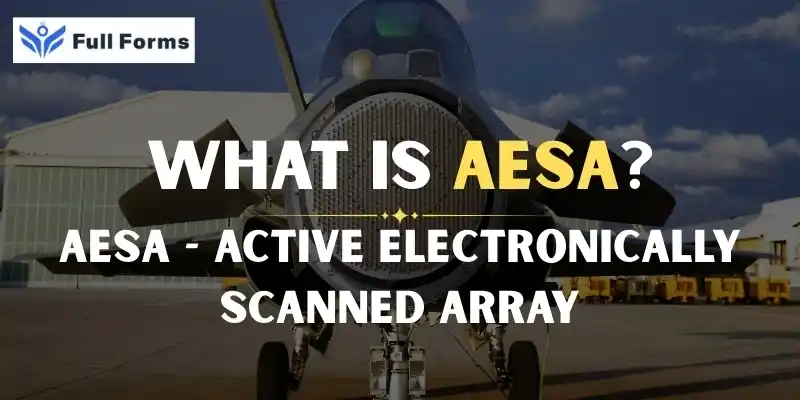Active Electronically Scanned Array
(AESA)

Description
Active Electronically Scanned Array: A New Way to Use Radar
Active Electronically Scanned Array Radars are a game-changer in the rapidly changing world of military and civilian radar systems. These radars can change the way we detect, track, and watch things with speed, accuracy, and flexibility that no other technology can match. It is these very AESA radars that have an inherent contribution inside fighter jets to naval ships and air defense systems toward modern implementations of defense and communication networks.
What is an Active Electronically Scanned Array?
An AESA or Active Electronically Scanned Array is a type of radar having many small antenna elements, each being driven by its own transmitter and receiver module. In contrast to conventional radars where the big single antenna has to be physically rotated in order to scan the environment, AESA radars steer the beam electronically by changing the phase of signals sent to each element.
Electronic steering allows the radar to quickly change its beam direction with no moving parts, offering nearly instant scanning ability over a large area. Thus, AESA radars come out not only faster but also more reliable and capable of such multitasking operations as tracking several targets at one time or undertaking communication work in parallel with regular radar duties.
AESA technology contains an array or grid of some hundreds to thousands of minute antenna elements. Every element sends out and receives radio waves independently, being controlled by highly intelligent electronics known as Transmit/Receive Modules (TRMs).
By carefully controlling the timing (phase) of the signals that is sent out from each antenna, it is possible to direct the radar beam electronically to different angles. This beam steering occurs within microseconds and hence enables the radar to scan large volumes of space with great speed as well as with high precision.
Because every antenna element is alive, AESA can in fact send many beams at the same time or hop between frequencies to match any form of interference and jamming being dealt with- this flexibility puts AESA radars at the top of their game even in complicated electronic warfare environments.
Benefits of AESA Radar Technology
Fast Beam Steering: Since there is no mechanical movement required, targeting and tracking can happen almost instantaneously over a wide field of view.
Multi-Target Tracking: Dozens, even hundreds of targets can be tracked simultaneously. The more targets that are tracked, the better threat response is, and situational awareness is enhanced.
Low Probability of Intercept. Rapid frequency changes plus beam pattern changes make it very difficult for enemy sensors to pick up on AESA radars. Better stealth capability.
Greater Reliability. No moving parts means no mechanical failures to the extent experienced with current systems which translates into less maintenance and more time in operation.
The AESA radar is capable of performing search, track, missile guidance, and communications at once thereby truly integrating many roles into one system.
AESA Technology Applications
These radars come as standard equipment on the world’s most advanced fighter jets, such as F-22 Raptors and F-35 Lightning II. With their speed, precision, and pilot intuition enabled to its maximum potential for situational awareness, with the ability to detect and engage threats at extreme ranges.
Warships apply AESA radars for the execution of roles in air and surface surveillance, missile guidance, and electronic warfare. The capability of the radars to track many incoming threats on different paths makes them important in defense against missile attacks.
Ground-Based Air Defense: AESA radars are quick to detect and track support for missile defense systems so that they may intercept approaching projectiles as well as protect vital infrastructure.
Civilian Uses: Outside the military, AESA helps better weather radar, more accurate air traffic control, and clearer satellite communication making safety stronger with better data quality.
Challenges and Future Developments
Though having many benefits, AESA is very techy and expensive to create and make. Every transmit/receive part needs to be well-designed. The electronics need good cooling to work right.
Further research is being done on the miniaturization, lightening, and lowering of the energy consumption of AESA systems so that they may be used by such small platforms as drones or unmanned vehicles. Further advances in materials science and semiconductor technology will no doubt lead to even greater performance improvements.
Artificial intelligence and machine learning are next being integrated into AESA radar systems to automatically identify targets and threats against a backdrop of war.
Conclusion
Active Electronically Scanned Array radar represents a major step forward in radar technology, matched by no system heretofore for speed, accuracy, or versatility. A product of the evolution from mechanically scanned arrays to highly sophisticated electronically controlled systems, AESA radars confer decisive advantages on both military and civilian operators in detection, tracking, and communications. With continuing development fostered by advancing technologies, AESA will shape radar futures to assure the best situation awareness in an increasingly complicated world.
